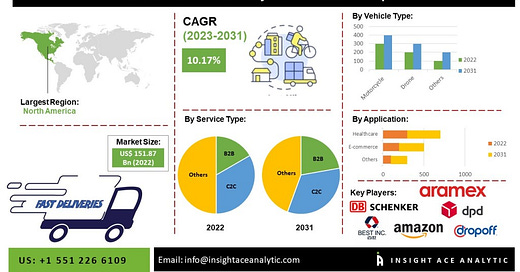The unit economics of Drone Delivery and some boring analysis.
Hey folks 👋, Bala here with another issue of OpsWorld. If it's your first time here, we generally write about technology and how it impacts the world of Operations.
Before we begin,
OpsWorld is created by the team at ZORP. In simple terms, ZORP is the OS for Operations. It’s a powerful suite of Products for Modern Operations teams who care about efficiency🚀.
Look at this report
This report predicts nothing surprising. In fact, it says that everything is going to remain the same. I’ve not read the underlying data on this, so I’ll refrain from commenting. But if I were a betting man, I would bet that this is not going to be the case.
But for today, we’ll focus on a different topic - Drones.
Why do drones make sense?
If you look at the Unit economics of a last mile business, the major cost constraint is labour. It is probably the highest cost item across most operations. Assuming that the overheads are the same (The might be in favor of drones tbf), here’s what the appx cost structure looks like.
Now, given all this, where are we with respect to Drones?
Delivery Capabilities:
To be frank, delivery by drones are still in pilot. The technology has still not evolved to ensure reliable delivery to customer locations.
Companies like Zipline have been pioneering this for a few years now across specific use cases. But they still have a long way to go. But new innovations like their latest home delivery drone show that we’re heading in the right direction.
The main implementation of Drone delivery will be in the Suburban areas but the current state of things leave a lot for wanting. Few things to address are
Delivery point
Safety of people and properties during delivery
Safety of delivered goods
Regulations
Drones offer a lot of information over the areas they fly. This inherently calls for regulations from the government. There are still open questions over how privacy concerns of citizens, security concerns of critical infrastructure etc need to be managed.
Here’s what the regulations look like right now in the US.
Part 107 Certification: Commercial drone operators must obtain a Remote Pilot Certificate under Part 107, which requires passing an FAA knowledge test.
Registration: Drones used for delivery must be registered with the FAA, and the registration number must be displayed on the drone.
Drone Weight: The drone's maximum takeoff weight, including the payload, must not exceed 55 lbs (25 kg).
Visual Line-of-Sight (VLOS): The drone must remain within the operator's or a visual observer's line of sight at all times.
Airspace Restrictions: Drone operators must obtain FAA authorization to fly in controlled airspace (e.g., near airports). They must also comply with any airspace restrictions, such as those imposed over sensitive areas or during emergency situations.
Operating Hours: Drone deliveries can only be conducted during daylight hours, or within 30 minutes of sunrise or sunset with appropriate anti-collision lighting.
Speed and Altitude: Drones cannot exceed a groundspeed of 100 mph (87 knots) and must not fly higher than 400 feet above ground level.
Right of Way: Drones must yield the right of way to other aircraft and cannot fly over people or moving vehicles.
No Hazardous Materials: Delivery drones cannot transport hazardous materials.
Package Drop-Off: The drone must land to release the package, and package drop-offs must not cause undue hazard to persons or property.
There are countries where the regulations are slightly ahead or worse than these laws but they all fall under similar structure. As you can see, a lot of regulations need to be adhered to before drones become mainstream.
On a closing note, while we see the limitations in terms of regulations and technical capabilities right now, the benefits outweigh the problems. This means, the market is incentivized to figure out solutions for these soon. This makes me feel optimistic about the future of last mile delivery and sufficient reduction in costs.
Did you find this useful? If so, consider sharing it in your network. If there is a specific topic in Operations that you want me to address, do let me know in the comments.





